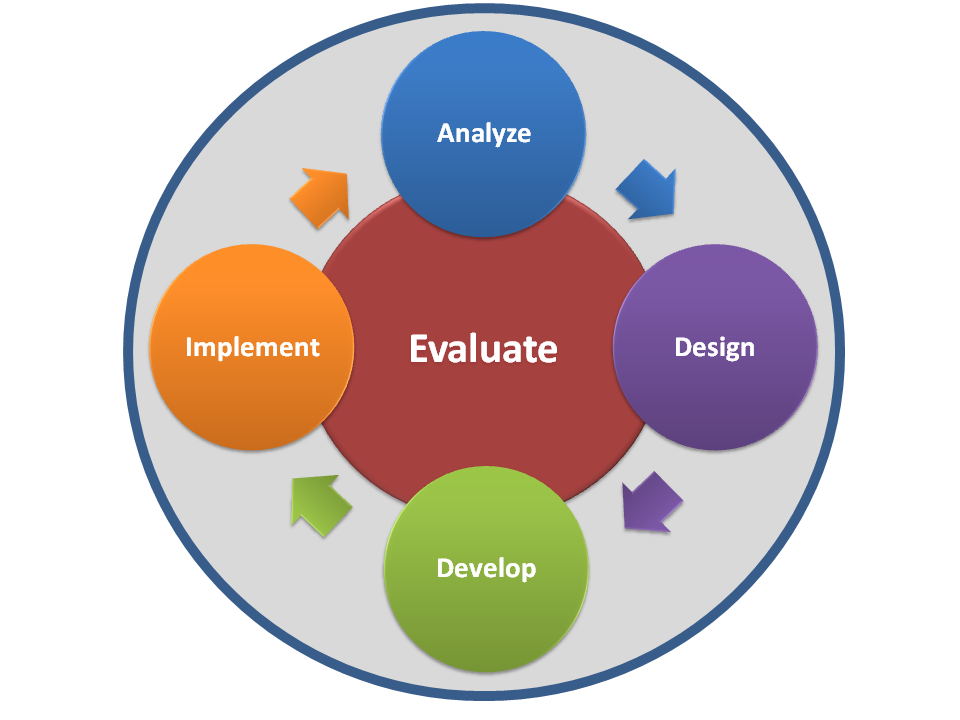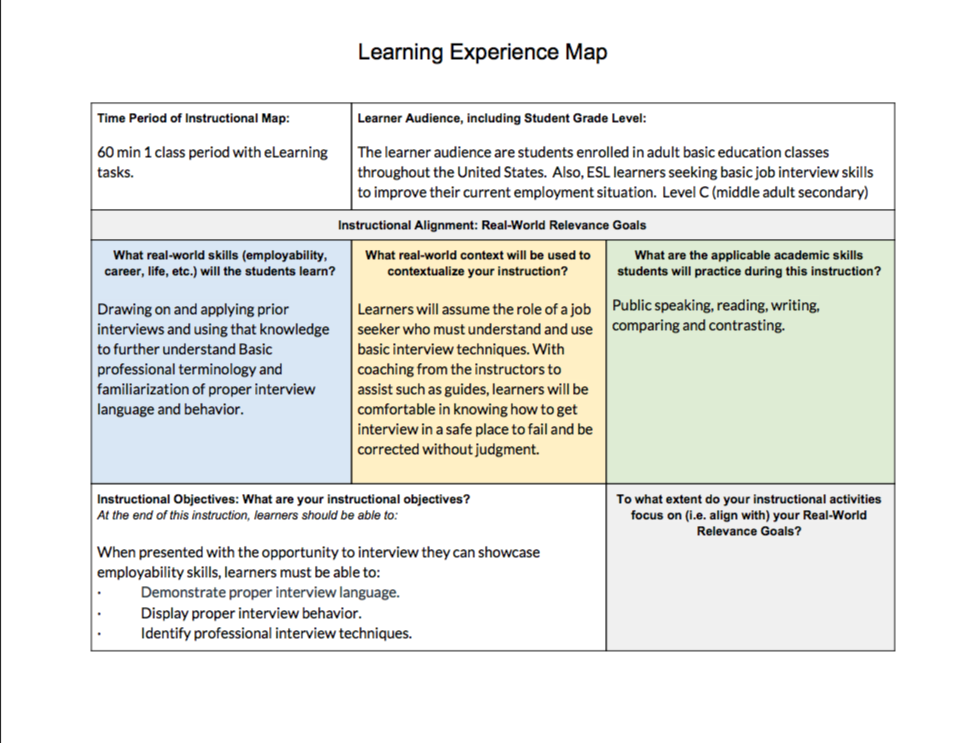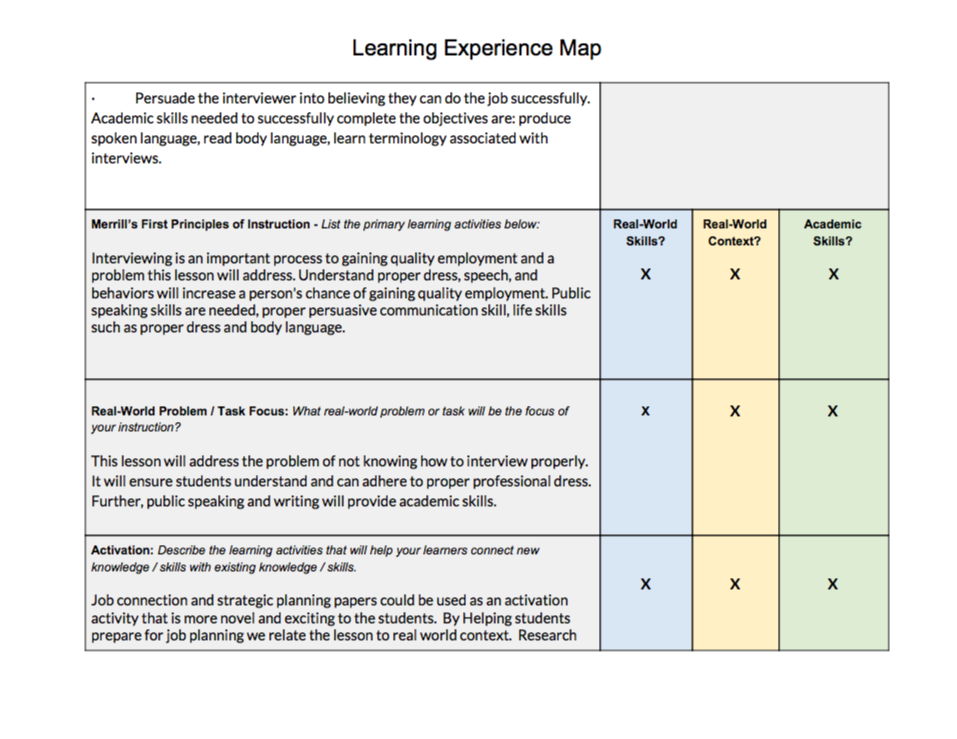

(Rogers, 2016)
In this blog post, lets delve back into the Designer for Learning project and look at understanding the process of evaluating a learning experience. I choose this lesson and as you can see it is lacking some basic fundamental instructional design best practices.
First lets look at the evaluation process.
List of Measurable Verbs Used to Assess Learning Outcomes
When looking at the lesson plan I reflected on these questions:
Do the learning objectives describe skills and knowledge associated with a problem or task that has a real-life purpose?
To what extent are the learning objectives specific, outcome-based, and measurable? Do they describe the desired learner behavior?
Are the learning objectives appropriately aligned with the College and Career Readiness Standards?
Are the selected action verbs within the learning objectives applicable to the desired level of learning (based on Bloom’s taxonomy)?
For any deficiencies you noted in the lesson’s learning objectives, try your hand at drafting improved learning objectives. By the end of the lesson, the adult learner should be able to:
Glossary of over 1,200 instructional strategies developed by Kelly Jo Rowan
I also reviewed the lesson plan and related instructional materials to reflect on the following:
What specific activation activities (if any) are included within the lesson to activate the learners’ previous relevant experience with the topic of instruction?
To what extent do you feel these activation activities are effectively and efficiently designed?
What examples from either Adding TEC-Variety by Curtis J. Bonk and Elaine Khoo or Kelly Rowan’s glossary instructional strategies are applicable to the activations phase?
What are some other relevant life experiences that you could incorporate into a redesign of your lesson as part of an activation activity for the subject and topic of instruction you are evaluating, as well as the learner persona you are contemplating?
The purpose of the demonstration phase is to show learners how to apply skills instead of merely telling them what to do. Demonstration activities can provide a meaningful context to general information, help learners develop mental models about the concepts, attract the learners’ attention, and sustain their curiosity. While demonstration activities are used to deliver the content, the learners don’t need to be passive recipients.
Citing research on instruction, Merrill (2007, p. 10) suggests demonstration activities should:
Demonstrate through examples what is to be learned rather than merely telling information about what is to be learned.
Provide demonstrations that are consistent with the content being taught, including examples and non-examples for kinds-of (i.e. concepts), demonstrations for how-to (i.e. procedures), and visualizations for what-happens (i.e. processes).
Include learner guidance techniques, such as directing the learner’s attention to relevant information, including and comparing multiple representations, relating new information to previously recalled or provided information.
Incorporate media that are relevant to the content and used to enhance learning.
The Evaluation Decisions were made after reviewing the lesson plan, related instructional materials, and reflecting on the following:
What types of demonstration activities (if any) are included within the lesson to demonstrate (versus tell) what is to be learned?
Are these demonstration activities consistent with the lesson’s learning goals and the to-be-learned skills and knowledge?
How is the learner is guided through the demonstration activities (e.g., from an instructor or instructions in the material)?
To what extent do you feel these demonstration activities are effectively and efficiently designed?
What examples from either Adding TEC-VarietyLinks to an external site. by Curtis J. Bonk and Elaine Khoo or Kelly Rowan’s glossary instructional strategiesLinks to an external site. are applicable to demonstration?
What are some other types of presentation, storytelling, or other demonstration strategies you could incorporate into a redesign of your lesson?
Application: Overview
The purpose of application phase is to elevate learning from passive reading and watching to applying and creating knowledge. This phase includes the instructional interactions with the content, the instructor, and others that facilitate practice of knowledge and skills. After a skill is demonstrated, the learners should be given ample opportunities to apply their new knowledge with guidance and feedback that is corrective, specific, and timely. Citing research on instruction, Merrill (2007, p. 12). Suggests application activities should:
Give learners an opportunity to practice and apply their newly acquired knowledge or skill.
Include application (practice) and assessment (tests) consistent with the stated or implied objectives.
Follow practice with corrective feedback, and an indication of progress (as opposed to just right-wrong feedback).
Offer learners access to help or provide coaching when they are having difficulty in solving the problem or doing the task wherein coaching gradually diminishes with each subsequent task until learners are performing on-their-own.
Require learners to use their new knowledge or skill to solve a varied sequence of problems or complete a varied sequence of tasks.
The following are a few examples of activities can be used for the application phase.
Practice activities help your learners apply knowledge and skills taught during the instruction.
Discovery and case study activities can be used to motivate and encourage your learners to invest mental effort in practices or problem-solving.
Games and Simulations can be used to have your learners apply information in a more realistic environment to motivate them.
Evaluation Decisions were made after reviewing the lesson plan, related instructional materials, and reflecting on the following:
What specific application activities (if any) are included within the lesson that require learners to use (apply) the new skill or knowledge?
Is the learner guided in their application / problem solving via feedback and coaching? If so, what learner guidance (from an instructor or the materials) is given within the designed application activities?
Are the learner practice opportunities consistent with lesson’s objectives?
Overall, to what extent do you feel these application activities are effectively and efficiently designed?
What examples from either Adding TEC-Variety by Curtis J. Bonk and Elaine Khoo or Kelly Rowan’s glossary instructional strategies are applicable to the application phase?
What other application activities could incorporate into a redesign of your lesson for the subject and topic of instruction you are evaluating, as well as the learner persona you are contemplating?
The instructional goal must be the learners who know what to do with the newly learned information. If they have information without knowing how and when to use, your instruction has not reached its goal. This situation is similar to having the latest version of a smartphone, but still using it only for phone calls because you do not know what to do with other features. Citing research on instruction, Merrill (2007, p. 13). Integration activities should provide:
Techniques that encourage learners to integrate (transfer) the new knowledge or skill into their everyday life.
Opportunity for the learner to publicly demonstrate their new knowledge or skill.
Opportunity for learners to reflect-on, discuss, and defend their new knowledge or skill.
Opportunity for learners to create, invent, or explore new and personal ways to use their new knowledge or skill.
Examples of types of integration phase activities include:
Ponder activities aid your learners to think broadly and deeply about a topic.
Stories by learners encourage your learners to correlate new information with their life.
Job aids help your learners as a reminder to apply their learning to real-life situations.
Research activities encourage your learners to discover and use their own sources of information.
Evaluation Decisions
What specific integration activities (if any) are included within the lesson that require learners to reflect upon, discuss, defend, use, or demonstrate the new skill or knowledge in their everyday life?
What learner guidance (from an instructor or the materials) is needed within these integration activities?
To what extent do you feel these integration activities are effectively and efficiently designed? When evaluating and designing integration activities, keep in mind that effective integration activities prompt learners to reflect what they learn by describing their experiences and challenges, and encourage them to apply new knowledge and skills into their life, or relate their new knowledge to future goals.
What examples from either Adding TEC-Variety by Curtis J. Bonk and Elaine Khoo or Kelly Rowan’s glossary instructional strategies are applicable to the integration phase?
What other integration activities could incorporate into a redesign of your lesson for the subject and topic of instruction you are evaluating, as well as the learner persona you are contemplating?
As noted previously, learning objectives also play a role in learner assessment. At points in the learning experience, assessments are needed to determine whether or not learners are able to achieve or master the learning objectives.
In general, there are two types of design assessments:
Formative assessment measures student learning during the learning process,
Summative assessment measures learning that occurs at the end of the learning experience.
Below is a list of assessment considerations from the:
WGBH Educational Foundations, The Guiding Principles of AssessmentLinks to an external site.
Assessments measure students’ attainment of learning outcomes.
Assessments measure the level of student success.
There should be a connection between the way students learn the material and the way they are tested on it.
Assessments should be varied.
Assessments include formal and informal evaluations.
Students should know the assessment plan at the beginning of a course.
I Reviewed the lesson plan, related instructional materials, and reflected on the following:
What types of formative and summative assessment activities are incorporated into the lesson you are evaluating to measure the learners’ attainment (or mastery) of the learning outcomes?
To what extent is the learner given the opportunity to display his / her new skill and knowledge improvement in appropriate assessments linked to the stated learning objectives?
What are ways that you can redesign the assessment(s) to better connect the way the material is learned and the way the learners are assessed?
How can you vary the assessments to include both formal and informal assessments?
In addition to contemplating the extent to which the lesson includes sound instructional principles discussed previously, I evaluated additional items that are described below, including:
Content Elements
Course Structure and Sequencing
Learner Experience
Instructional Media
Affective Consideration
Content sufficiency: Is the content prepared for the lesson sufficient to support course goals and objectives?
Relevance: Are the lesson topics and presented content in the instructional materials relevant to our target adult learners?
Level: Is the content appropriate for the learning level of our target adult learners?
Accuracy: Is the content free of errors, jargon, and cultural bias?
Length: Is the instructional unit of appropriate length, and can the learner complete the lesson within the estimated time frames?
I considered the extent to which the following were effectively and efficiently designed within the lesson:
How the content and instructional activities will be sequenced
How and when learners will engage in active practice and reflection
How and when learner assessment will occur
How and when learner guidance will be offered
I contemplated the degree to which the following learner experience, material design, and course navigation were effectively and efficiently presented:
Lesson introduction
Directions and help for the instructor and learners
Lesson navigation
Lesson conclusion
Overall ease of use
I Deliberated the instructional media elements efficiency and effectiveness in supporting the designed instructional approaches, and if any media elements should be added / amended to better support the instructional delivery:
Text
Images and graphics
Audio
Animation and Video
Links to Resources
Printable Documents
I ruminated the scope to which the lesson was likely to accomplish the following for the target audience of learners:
Arouse curiosity
Establish relevance
Offer appropriate level of challenge
Maintain a learner’s attention
Multimedia for learning: Methods and development
I Looked for other areas of need as this list is not extensive.
Take a look at excerpts of my notes to see how I evaluated the instruction:
This learning objective does address the problem of poor interview behaviors.
The learning objectives are measurable through observation, and student work.
This does not align to any of the specific CCRS standards as they outline information on speaking properly and understand someone but not body language or behaviors.
Illustrate is used which is an action verb describing an action to be taken; however, demonstrate would be more applicable.
Objective: The student will demonstrate proper interview language and behavior.
The use of a KWL chart acts as an activation component.
They are effective and efficient especially for students with a lack of Internet options. Very simple any instructor would have the resources for.
Job connection and strategic planning papers could be used as an activation activity that is more novel and exciting to the students.
Any life experiences in which the student had to interact with authority times when it went badly and times it went well.
Examples are provided through a YouTube video presentation of a poor interview. Although, a proper interview is not available to contrast the first video.
How-to is not provided as the lesson expects the learners to teach themselves the proper interview behaviors.
Guidance is not provided, and relevant information is not pointed out.
Nothing is compared and contrasted with higher learning skills.
Previously recalled information is not used.
Activity 54. Language Learning Conversations and Mentoring of TEC-Variety would be applicable to demonstration.
The lesson uses role-playing to demonstrate new skills.
Coaching is not mentioned in this lesson.
The practice opportunities are aligned to the objective.
The design is poor and lacking detail for the teacher and student.
Activity 56. Cross-Cultural Web Conferencing and Interactions of TEC-Variety would provide an opportunity for students to practice via Skype.
An incorporation of an online game in which learners chose proper attire would be helpful.
This lesson needs to be more interactive it is very barebones with only a single video for instruction. There is a lack of coaching and direction given to the teacher and students.
I hope to make the learning experience engaging and applicable to real-life. Providing more interaction and instruction has the ability to liven up the lesson. Further, some eLearning in the design would be beneficial for the student and the instructor.



References
Merrill, M. D. (2007). First principles of instruction: a synthesis. In R. A. Reiser & J. V. Dempsey (Eds.), Trends and Issues in Instructional Design and Technology, 2nd Edition (Vol. 2, pp. 62-71). Upper Saddle River, NJ: Merrill/Prentice Hall. Retrieved From Here
Rogers, S. (2016) Instructional and Learner Analysis in Instructional Design. Teacher Rogers Blog. Retrieved From Here